University Marketing Report: Hopkinson's Coffee Company Strategy
VerifiedAdded on 2022/08/31
|8
|3749
|18
Report
AI Summary
This report analyzes the marketing strategies of Hopkinson's Coffee Company, a small coffee business in Bristol, UK. The report evaluates the company's current position, including its strengths in sustainability and human resource management, as well as weaknesses in marketing, website usage, and facilities. It recommends improvements such as enhanced promotional strategies, strategic website utilization, and facility upgrades. The report also identifies associated risks, including investment requirements for promotions and brand awareness, and the need for careful platform selection. The analysis is based on a market audit and aims to ensure the company's sustainability in a competitive market. The assignment follows the guidelines provided by the Faculty of Business and Law, UMKC8T-15-M module, and Dr. Mario Vafeas, which includes a critical reflection on the theories and frameworks used, along with the inclusion of a marketing audit in the appendix.
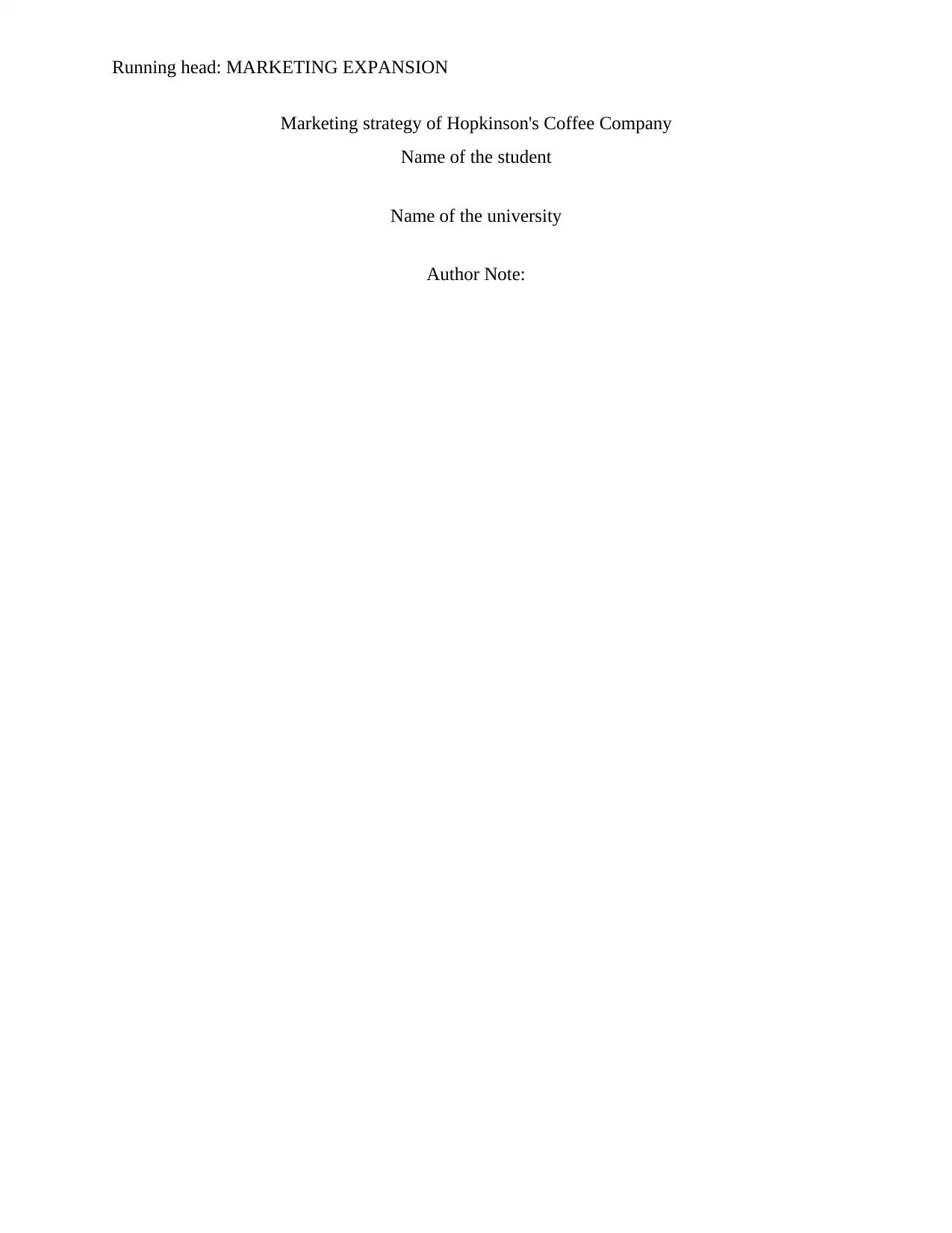
Running head: MARKETING EXPANSION
Marketing strategy of Hopkinson's Coffee Company
Name of the student
Name of the university
Author Note:
Marketing strategy of Hopkinson's Coffee Company
Name of the student
Name of the university
Author Note:
Paraphrase This Document
Need a fresh take? Get an instant paraphrase of this document with our AI Paraphraser
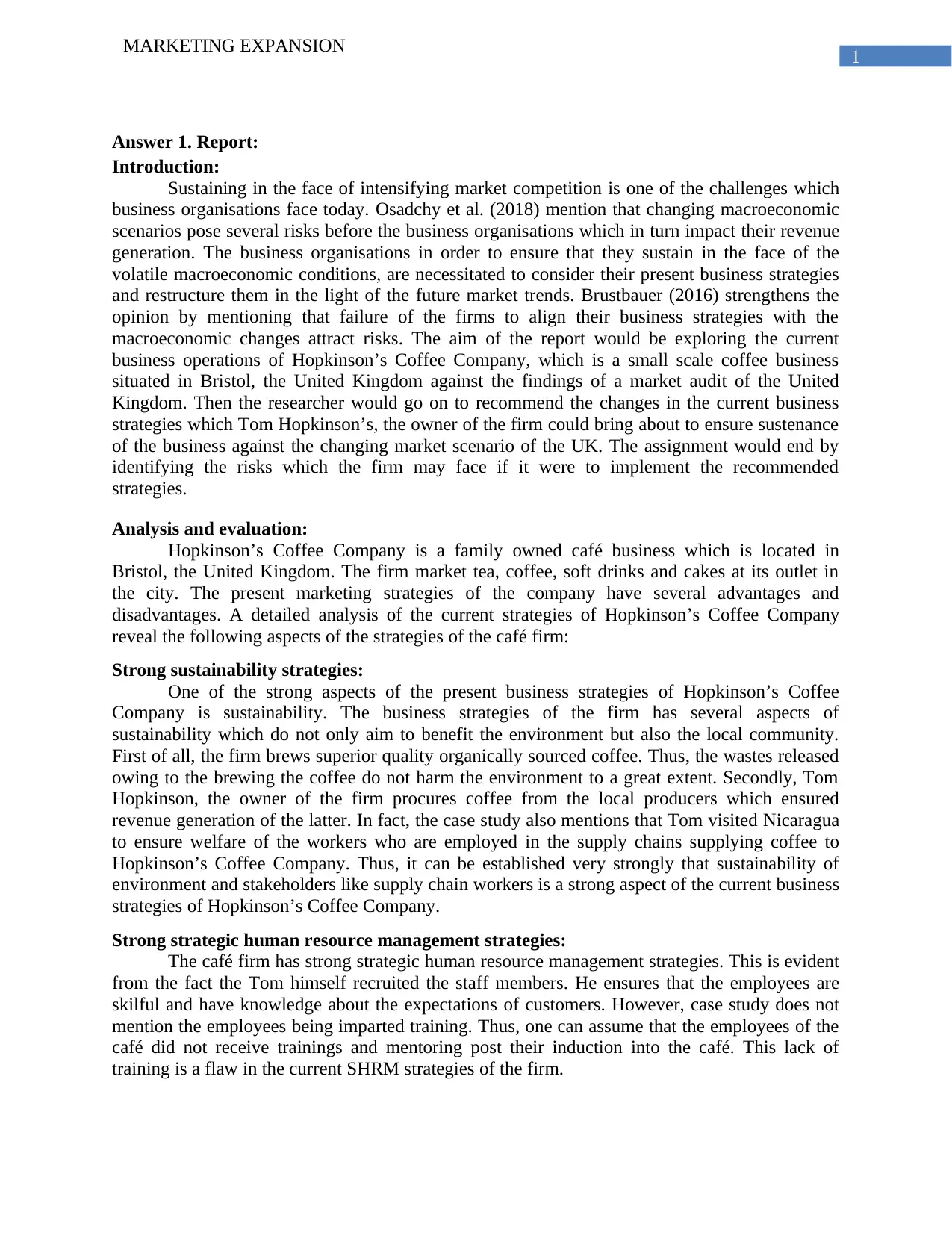
1
MARKETING EXPANSION
Answer 1. Report:
Introduction:
Sustaining in the face of intensifying market competition is one of the challenges which
business organisations face today. Osadchy et al. (2018) mention that changing macroeconomic
scenarios pose several risks before the business organisations which in turn impact their revenue
generation. The business organisations in order to ensure that they sustain in the face of the
volatile macroeconomic conditions, are necessitated to consider their present business strategies
and restructure them in the light of the future market trends. Brustbauer (2016) strengthens the
opinion by mentioning that failure of the firms to align their business strategies with the
macroeconomic changes attract risks. The aim of the report would be exploring the current
business operations of Hopkinson’s Coffee Company, which is a small scale coffee business
situated in Bristol, the United Kingdom against the findings of a market audit of the United
Kingdom. Then the researcher would go on to recommend the changes in the current business
strategies which Tom Hopkinson’s, the owner of the firm could bring about to ensure sustenance
of the business against the changing market scenario of the UK. The assignment would end by
identifying the risks which the firm may face if it were to implement the recommended
strategies.
Analysis and evaluation:
Hopkinson’s Coffee Company is a family owned café business which is located in
Bristol, the United Kingdom. The firm market tea, coffee, soft drinks and cakes at its outlet in
the city. The present marketing strategies of the company have several advantages and
disadvantages. A detailed analysis of the current strategies of Hopkinson’s Coffee Company
reveal the following aspects of the strategies of the café firm:
Strong sustainability strategies:
One of the strong aspects of the present business strategies of Hopkinson’s Coffee
Company is sustainability. The business strategies of the firm has several aspects of
sustainability which do not only aim to benefit the environment but also the local community.
First of all, the firm brews superior quality organically sourced coffee. Thus, the wastes released
owing to the brewing the coffee do not harm the environment to a great extent. Secondly, Tom
Hopkinson, the owner of the firm procures coffee from the local producers which ensured
revenue generation of the latter. In fact, the case study also mentions that Tom visited Nicaragua
to ensure welfare of the workers who are employed in the supply chains supplying coffee to
Hopkinson’s Coffee Company. Thus, it can be established very strongly that sustainability of
environment and stakeholders like supply chain workers is a strong aspect of the current business
strategies of Hopkinson’s Coffee Company.
Strong strategic human resource management strategies:
The café firm has strong strategic human resource management strategies. This is evident
from the fact the Tom himself recruited the staff members. He ensures that the employees are
skilful and have knowledge about the expectations of customers. However, case study does not
mention the employees being imparted training. Thus, one can assume that the employees of the
café did not receive trainings and mentoring post their induction into the café. This lack of
training is a flaw in the current SHRM strategies of the firm.
MARKETING EXPANSION
Answer 1. Report:
Introduction:
Sustaining in the face of intensifying market competition is one of the challenges which
business organisations face today. Osadchy et al. (2018) mention that changing macroeconomic
scenarios pose several risks before the business organisations which in turn impact their revenue
generation. The business organisations in order to ensure that they sustain in the face of the
volatile macroeconomic conditions, are necessitated to consider their present business strategies
and restructure them in the light of the future market trends. Brustbauer (2016) strengthens the
opinion by mentioning that failure of the firms to align their business strategies with the
macroeconomic changes attract risks. The aim of the report would be exploring the current
business operations of Hopkinson’s Coffee Company, which is a small scale coffee business
situated in Bristol, the United Kingdom against the findings of a market audit of the United
Kingdom. Then the researcher would go on to recommend the changes in the current business
strategies which Tom Hopkinson’s, the owner of the firm could bring about to ensure sustenance
of the business against the changing market scenario of the UK. The assignment would end by
identifying the risks which the firm may face if it were to implement the recommended
strategies.
Analysis and evaluation:
Hopkinson’s Coffee Company is a family owned café business which is located in
Bristol, the United Kingdom. The firm market tea, coffee, soft drinks and cakes at its outlet in
the city. The present marketing strategies of the company have several advantages and
disadvantages. A detailed analysis of the current strategies of Hopkinson’s Coffee Company
reveal the following aspects of the strategies of the café firm:
Strong sustainability strategies:
One of the strong aspects of the present business strategies of Hopkinson’s Coffee
Company is sustainability. The business strategies of the firm has several aspects of
sustainability which do not only aim to benefit the environment but also the local community.
First of all, the firm brews superior quality organically sourced coffee. Thus, the wastes released
owing to the brewing the coffee do not harm the environment to a great extent. Secondly, Tom
Hopkinson, the owner of the firm procures coffee from the local producers which ensured
revenue generation of the latter. In fact, the case study also mentions that Tom visited Nicaragua
to ensure welfare of the workers who are employed in the supply chains supplying coffee to
Hopkinson’s Coffee Company. Thus, it can be established very strongly that sustainability of
environment and stakeholders like supply chain workers is a strong aspect of the current business
strategies of Hopkinson’s Coffee Company.
Strong strategic human resource management strategies:
The café firm has strong strategic human resource management strategies. This is evident
from the fact the Tom himself recruited the staff members. He ensures that the employees are
skilful and have knowledge about the expectations of customers. However, case study does not
mention the employees being imparted training. Thus, one can assume that the employees of the
café did not receive trainings and mentoring post their induction into the café. This lack of
training is a flaw in the current SHRM strategies of the firm.
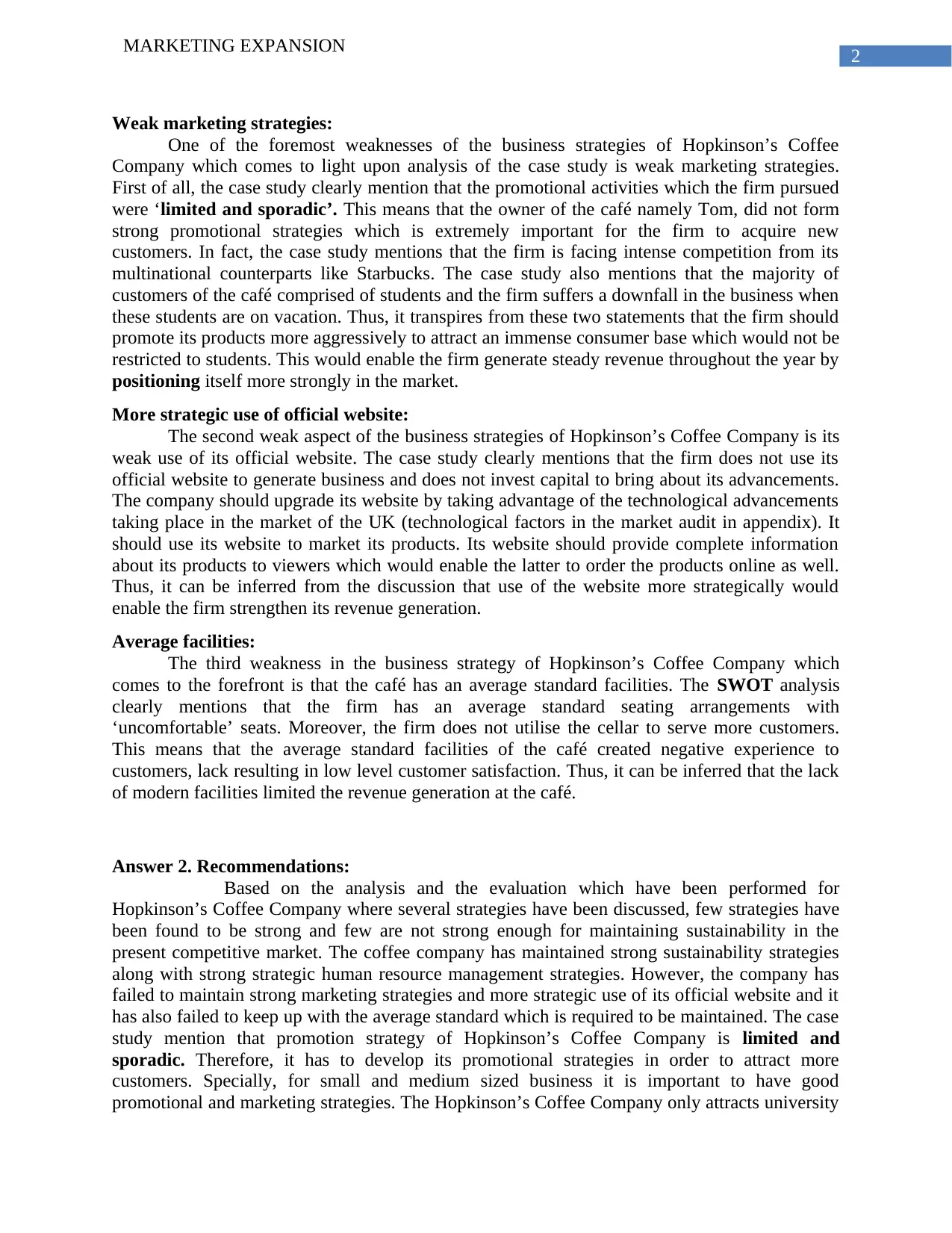
2
MARKETING EXPANSION
Weak marketing strategies:
One of the foremost weaknesses of the business strategies of Hopkinson’s Coffee
Company which comes to light upon analysis of the case study is weak marketing strategies.
First of all, the case study clearly mention that the promotional activities which the firm pursued
were ‘limited and sporadic’. This means that the owner of the café namely Tom, did not form
strong promotional strategies which is extremely important for the firm to acquire new
customers. In fact, the case study mentions that the firm is facing intense competition from its
multinational counterparts like Starbucks. The case study also mentions that the majority of
customers of the café comprised of students and the firm suffers a downfall in the business when
these students are on vacation. Thus, it transpires from these two statements that the firm should
promote its products more aggressively to attract an immense consumer base which would not be
restricted to students. This would enable the firm generate steady revenue throughout the year by
positioning itself more strongly in the market.
More strategic use of official website:
The second weak aspect of the business strategies of Hopkinson’s Coffee Company is its
weak use of its official website. The case study clearly mentions that the firm does not use its
official website to generate business and does not invest capital to bring about its advancements.
The company should upgrade its website by taking advantage of the technological advancements
taking place in the market of the UK (technological factors in the market audit in appendix). It
should use its website to market its products. Its website should provide complete information
about its products to viewers which would enable the latter to order the products online as well.
Thus, it can be inferred from the discussion that use of the website more strategically would
enable the firm strengthen its revenue generation.
Average facilities:
The third weakness in the business strategy of Hopkinson’s Coffee Company which
comes to the forefront is that the café has an average standard facilities. The SWOT analysis
clearly mentions that the firm has an average standard seating arrangements with
‘uncomfortable’ seats. Moreover, the firm does not utilise the cellar to serve more customers.
This means that the average standard facilities of the café created negative experience to
customers, lack resulting in low level customer satisfaction. Thus, it can be inferred that the lack
of modern facilities limited the revenue generation at the café.
Answer 2. Recommendations:
Based on the analysis and the evaluation which have been performed for
Hopkinson’s Coffee Company where several strategies have been discussed, few strategies have
been found to be strong and few are not strong enough for maintaining sustainability in the
present competitive market. The coffee company has maintained strong sustainability strategies
along with strong strategic human resource management strategies. However, the company has
failed to maintain strong marketing strategies and more strategic use of its official website and it
has also failed to keep up with the average standard which is required to be maintained. The case
study mention that promotion strategy of Hopkinson’s Coffee Company is limited and
sporadic. Therefore, it has to develop its promotional strategies in order to attract more
customers. Specially, for small and medium sized business it is important to have good
promotional and marketing strategies. The Hopkinson’s Coffee Company only attracts university
MARKETING EXPANSION
Weak marketing strategies:
One of the foremost weaknesses of the business strategies of Hopkinson’s Coffee
Company which comes to light upon analysis of the case study is weak marketing strategies.
First of all, the case study clearly mention that the promotional activities which the firm pursued
were ‘limited and sporadic’. This means that the owner of the café namely Tom, did not form
strong promotional strategies which is extremely important for the firm to acquire new
customers. In fact, the case study mentions that the firm is facing intense competition from its
multinational counterparts like Starbucks. The case study also mentions that the majority of
customers of the café comprised of students and the firm suffers a downfall in the business when
these students are on vacation. Thus, it transpires from these two statements that the firm should
promote its products more aggressively to attract an immense consumer base which would not be
restricted to students. This would enable the firm generate steady revenue throughout the year by
positioning itself more strongly in the market.
More strategic use of official website:
The second weak aspect of the business strategies of Hopkinson’s Coffee Company is its
weak use of its official website. The case study clearly mentions that the firm does not use its
official website to generate business and does not invest capital to bring about its advancements.
The company should upgrade its website by taking advantage of the technological advancements
taking place in the market of the UK (technological factors in the market audit in appendix). It
should use its website to market its products. Its website should provide complete information
about its products to viewers which would enable the latter to order the products online as well.
Thus, it can be inferred from the discussion that use of the website more strategically would
enable the firm strengthen its revenue generation.
Average facilities:
The third weakness in the business strategy of Hopkinson’s Coffee Company which
comes to the forefront is that the café has an average standard facilities. The SWOT analysis
clearly mentions that the firm has an average standard seating arrangements with
‘uncomfortable’ seats. Moreover, the firm does not utilise the cellar to serve more customers.
This means that the average standard facilities of the café created negative experience to
customers, lack resulting in low level customer satisfaction. Thus, it can be inferred that the lack
of modern facilities limited the revenue generation at the café.
Answer 2. Recommendations:
Based on the analysis and the evaluation which have been performed for
Hopkinson’s Coffee Company where several strategies have been discussed, few strategies have
been found to be strong and few are not strong enough for maintaining sustainability in the
present competitive market. The coffee company has maintained strong sustainability strategies
along with strong strategic human resource management strategies. However, the company has
failed to maintain strong marketing strategies and more strategic use of its official website and it
has also failed to keep up with the average standard which is required to be maintained. The case
study mention that promotion strategy of Hopkinson’s Coffee Company is limited and
sporadic. Therefore, it has to develop its promotional strategies in order to attract more
customers. Specially, for small and medium sized business it is important to have good
promotional and marketing strategies. The Hopkinson’s Coffee Company only attracts university
⊘ This is a preview!⊘
Do you want full access?
Subscribe today to unlock all pages.

Trusted by 1+ million students worldwide
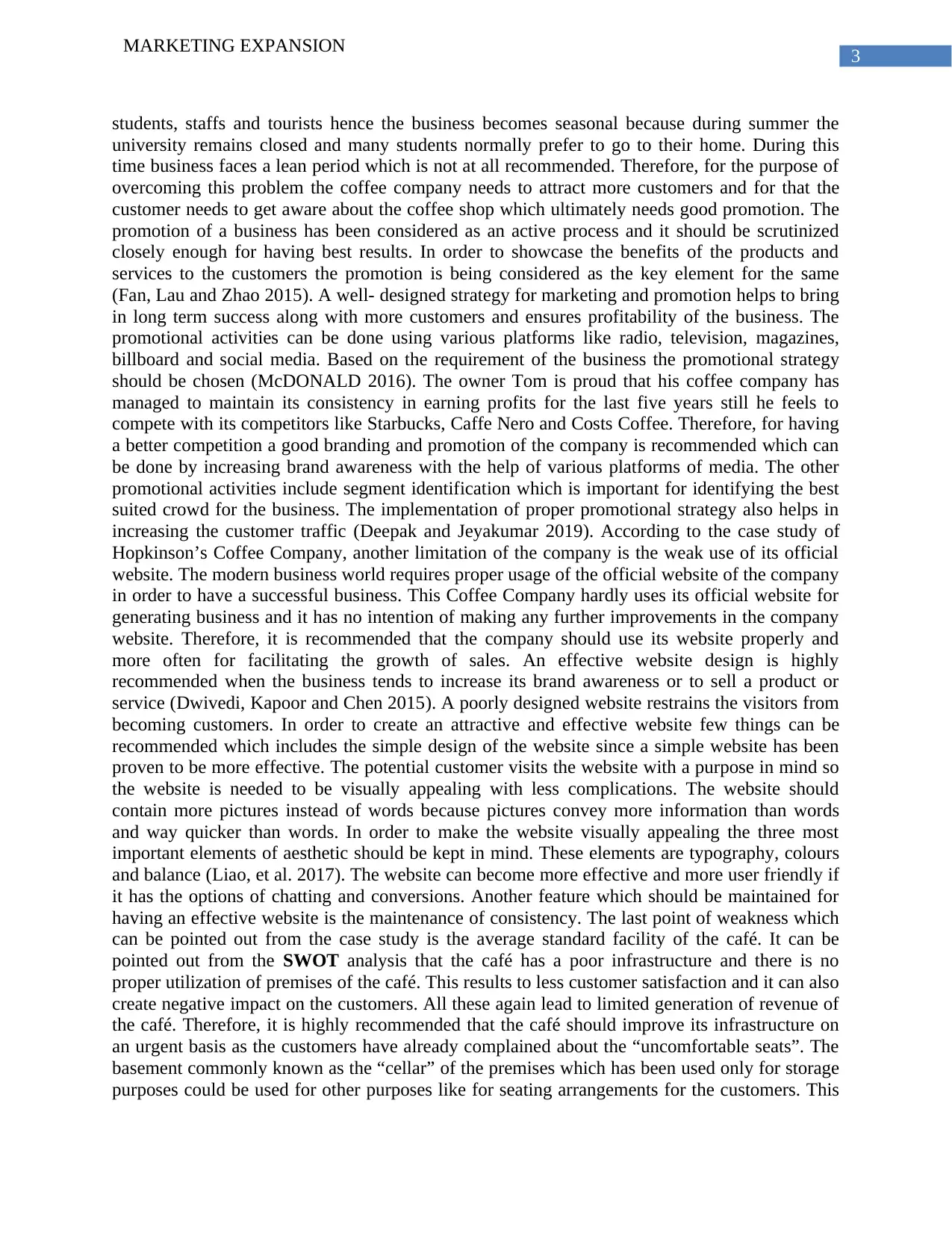
3
MARKETING EXPANSION
students, staffs and tourists hence the business becomes seasonal because during summer the
university remains closed and many students normally prefer to go to their home. During this
time business faces a lean period which is not at all recommended. Therefore, for the purpose of
overcoming this problem the coffee company needs to attract more customers and for that the
customer needs to get aware about the coffee shop which ultimately needs good promotion. The
promotion of a business has been considered as an active process and it should be scrutinized
closely enough for having best results. In order to showcase the benefits of the products and
services to the customers the promotion is being considered as the key element for the same
(Fan, Lau and Zhao 2015). A well- designed strategy for marketing and promotion helps to bring
in long term success along with more customers and ensures profitability of the business. The
promotional activities can be done using various platforms like radio, television, magazines,
billboard and social media. Based on the requirement of the business the promotional strategy
should be chosen (McDONALD 2016). The owner Tom is proud that his coffee company has
managed to maintain its consistency in earning profits for the last five years still he feels to
compete with its competitors like Starbucks, Caffe Nero and Costs Coffee. Therefore, for having
a better competition a good branding and promotion of the company is recommended which can
be done by increasing brand awareness with the help of various platforms of media. The other
promotional activities include segment identification which is important for identifying the best
suited crowd for the business. The implementation of proper promotional strategy also helps in
increasing the customer traffic (Deepak and Jeyakumar 2019). According to the case study of
Hopkinson’s Coffee Company, another limitation of the company is the weak use of its official
website. The modern business world requires proper usage of the official website of the company
in order to have a successful business. This Coffee Company hardly uses its official website for
generating business and it has no intention of making any further improvements in the company
website. Therefore, it is recommended that the company should use its website properly and
more often for facilitating the growth of sales. An effective website design is highly
recommended when the business tends to increase its brand awareness or to sell a product or
service (Dwivedi, Kapoor and Chen 2015). A poorly designed website restrains the visitors from
becoming customers. In order to create an attractive and effective website few things can be
recommended which includes the simple design of the website since a simple website has been
proven to be more effective. The potential customer visits the website with a purpose in mind so
the website is needed to be visually appealing with less complications. The website should
contain more pictures instead of words because pictures convey more information than words
and way quicker than words. In order to make the website visually appealing the three most
important elements of aesthetic should be kept in mind. These elements are typography, colours
and balance (Liao, et al. 2017). The website can become more effective and more user friendly if
it has the options of chatting and conversions. Another feature which should be maintained for
having an effective website is the maintenance of consistency. The last point of weakness which
can be pointed out from the case study is the average standard facility of the café. It can be
pointed out from the SWOT analysis that the café has a poor infrastructure and there is no
proper utilization of premises of the café. This results to less customer satisfaction and it can also
create negative impact on the customers. All these again lead to limited generation of revenue of
the café. Therefore, it is highly recommended that the café should improve its infrastructure on
an urgent basis as the customers have already complained about the “uncomfortable seats”. The
basement commonly known as the “cellar” of the premises which has been used only for storage
purposes could be used for other purposes like for seating arrangements for the customers. This
MARKETING EXPANSION
students, staffs and tourists hence the business becomes seasonal because during summer the
university remains closed and many students normally prefer to go to their home. During this
time business faces a lean period which is not at all recommended. Therefore, for the purpose of
overcoming this problem the coffee company needs to attract more customers and for that the
customer needs to get aware about the coffee shop which ultimately needs good promotion. The
promotion of a business has been considered as an active process and it should be scrutinized
closely enough for having best results. In order to showcase the benefits of the products and
services to the customers the promotion is being considered as the key element for the same
(Fan, Lau and Zhao 2015). A well- designed strategy for marketing and promotion helps to bring
in long term success along with more customers and ensures profitability of the business. The
promotional activities can be done using various platforms like radio, television, magazines,
billboard and social media. Based on the requirement of the business the promotional strategy
should be chosen (McDONALD 2016). The owner Tom is proud that his coffee company has
managed to maintain its consistency in earning profits for the last five years still he feels to
compete with its competitors like Starbucks, Caffe Nero and Costs Coffee. Therefore, for having
a better competition a good branding and promotion of the company is recommended which can
be done by increasing brand awareness with the help of various platforms of media. The other
promotional activities include segment identification which is important for identifying the best
suited crowd for the business. The implementation of proper promotional strategy also helps in
increasing the customer traffic (Deepak and Jeyakumar 2019). According to the case study of
Hopkinson’s Coffee Company, another limitation of the company is the weak use of its official
website. The modern business world requires proper usage of the official website of the company
in order to have a successful business. This Coffee Company hardly uses its official website for
generating business and it has no intention of making any further improvements in the company
website. Therefore, it is recommended that the company should use its website properly and
more often for facilitating the growth of sales. An effective website design is highly
recommended when the business tends to increase its brand awareness or to sell a product or
service (Dwivedi, Kapoor and Chen 2015). A poorly designed website restrains the visitors from
becoming customers. In order to create an attractive and effective website few things can be
recommended which includes the simple design of the website since a simple website has been
proven to be more effective. The potential customer visits the website with a purpose in mind so
the website is needed to be visually appealing with less complications. The website should
contain more pictures instead of words because pictures convey more information than words
and way quicker than words. In order to make the website visually appealing the three most
important elements of aesthetic should be kept in mind. These elements are typography, colours
and balance (Liao, et al. 2017). The website can become more effective and more user friendly if
it has the options of chatting and conversions. Another feature which should be maintained for
having an effective website is the maintenance of consistency. The last point of weakness which
can be pointed out from the case study is the average standard facility of the café. It can be
pointed out from the SWOT analysis that the café has a poor infrastructure and there is no
proper utilization of premises of the café. This results to less customer satisfaction and it can also
create negative impact on the customers. All these again lead to limited generation of revenue of
the café. Therefore, it is highly recommended that the café should improve its infrastructure on
an urgent basis as the customers have already complained about the “uncomfortable seats”. The
basement commonly known as the “cellar” of the premises which has been used only for storage
purposes could be used for other purposes like for seating arrangements for the customers. This
Paraphrase This Document
Need a fresh take? Get an instant paraphrase of this document with our AI Paraphraser
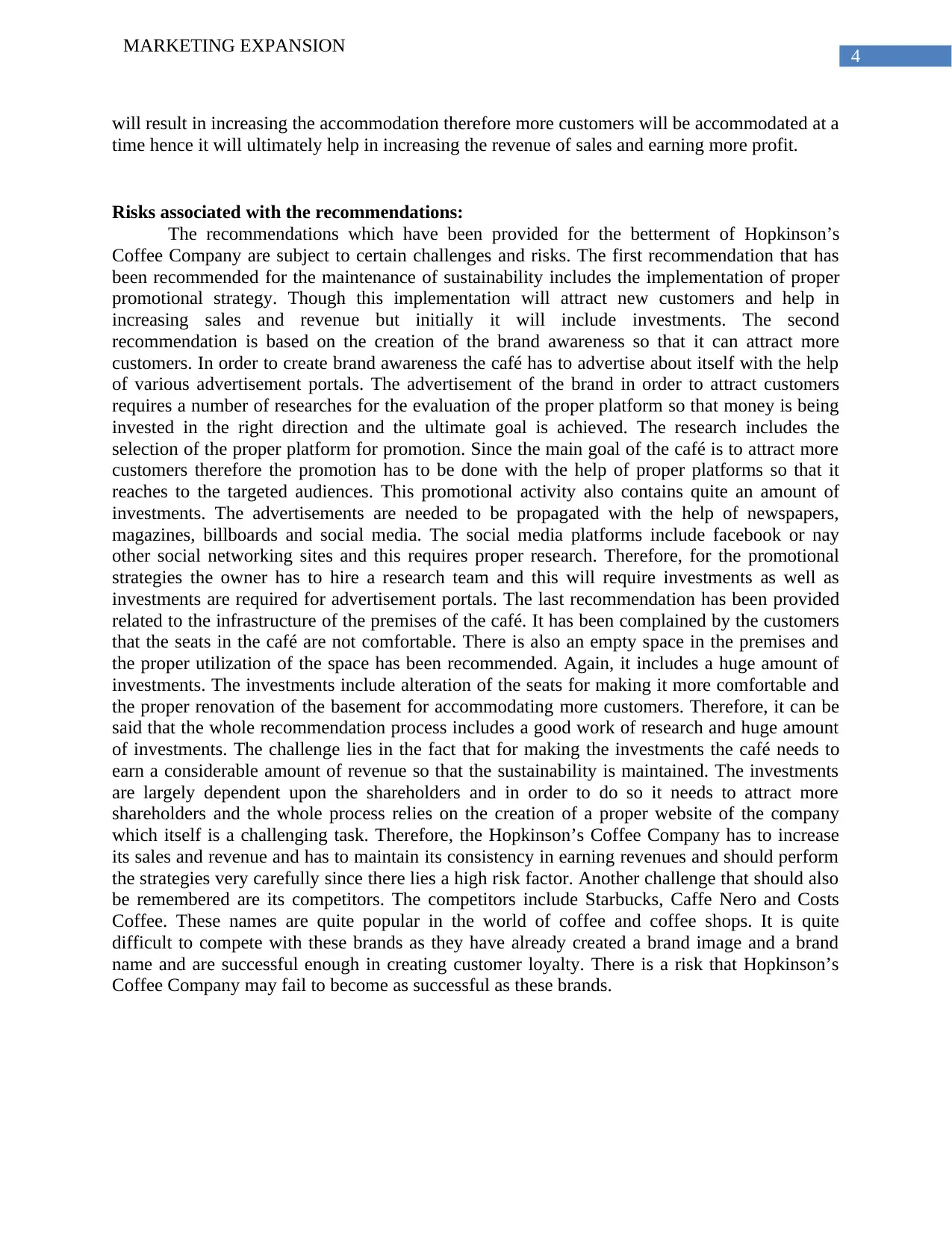
4
MARKETING EXPANSION
will result in increasing the accommodation therefore more customers will be accommodated at a
time hence it will ultimately help in increasing the revenue of sales and earning more profit.
Risks associated with the recommendations:
The recommendations which have been provided for the betterment of Hopkinson’s
Coffee Company are subject to certain challenges and risks. The first recommendation that has
been recommended for the maintenance of sustainability includes the implementation of proper
promotional strategy. Though this implementation will attract new customers and help in
increasing sales and revenue but initially it will include investments. The second
recommendation is based on the creation of the brand awareness so that it can attract more
customers. In order to create brand awareness the café has to advertise about itself with the help
of various advertisement portals. The advertisement of the brand in order to attract customers
requires a number of researches for the evaluation of the proper platform so that money is being
invested in the right direction and the ultimate goal is achieved. The research includes the
selection of the proper platform for promotion. Since the main goal of the café is to attract more
customers therefore the promotion has to be done with the help of proper platforms so that it
reaches to the targeted audiences. This promotional activity also contains quite an amount of
investments. The advertisements are needed to be propagated with the help of newspapers,
magazines, billboards and social media. The social media platforms include facebook or nay
other social networking sites and this requires proper research. Therefore, for the promotional
strategies the owner has to hire a research team and this will require investments as well as
investments are required for advertisement portals. The last recommendation has been provided
related to the infrastructure of the premises of the café. It has been complained by the customers
that the seats in the café are not comfortable. There is also an empty space in the premises and
the proper utilization of the space has been recommended. Again, it includes a huge amount of
investments. The investments include alteration of the seats for making it more comfortable and
the proper renovation of the basement for accommodating more customers. Therefore, it can be
said that the whole recommendation process includes a good work of research and huge amount
of investments. The challenge lies in the fact that for making the investments the café needs to
earn a considerable amount of revenue so that the sustainability is maintained. The investments
are largely dependent upon the shareholders and in order to do so it needs to attract more
shareholders and the whole process relies on the creation of a proper website of the company
which itself is a challenging task. Therefore, the Hopkinson’s Coffee Company has to increase
its sales and revenue and has to maintain its consistency in earning revenues and should perform
the strategies very carefully since there lies a high risk factor. Another challenge that should also
be remembered are its competitors. The competitors include Starbucks, Caffe Nero and Costs
Coffee. These names are quite popular in the world of coffee and coffee shops. It is quite
difficult to compete with these brands as they have already created a brand image and a brand
name and are successful enough in creating customer loyalty. There is a risk that Hopkinson’s
Coffee Company may fail to become as successful as these brands.
MARKETING EXPANSION
will result in increasing the accommodation therefore more customers will be accommodated at a
time hence it will ultimately help in increasing the revenue of sales and earning more profit.
Risks associated with the recommendations:
The recommendations which have been provided for the betterment of Hopkinson’s
Coffee Company are subject to certain challenges and risks. The first recommendation that has
been recommended for the maintenance of sustainability includes the implementation of proper
promotional strategy. Though this implementation will attract new customers and help in
increasing sales and revenue but initially it will include investments. The second
recommendation is based on the creation of the brand awareness so that it can attract more
customers. In order to create brand awareness the café has to advertise about itself with the help
of various advertisement portals. The advertisement of the brand in order to attract customers
requires a number of researches for the evaluation of the proper platform so that money is being
invested in the right direction and the ultimate goal is achieved. The research includes the
selection of the proper platform for promotion. Since the main goal of the café is to attract more
customers therefore the promotion has to be done with the help of proper platforms so that it
reaches to the targeted audiences. This promotional activity also contains quite an amount of
investments. The advertisements are needed to be propagated with the help of newspapers,
magazines, billboards and social media. The social media platforms include facebook or nay
other social networking sites and this requires proper research. Therefore, for the promotional
strategies the owner has to hire a research team and this will require investments as well as
investments are required for advertisement portals. The last recommendation has been provided
related to the infrastructure of the premises of the café. It has been complained by the customers
that the seats in the café are not comfortable. There is also an empty space in the premises and
the proper utilization of the space has been recommended. Again, it includes a huge amount of
investments. The investments include alteration of the seats for making it more comfortable and
the proper renovation of the basement for accommodating more customers. Therefore, it can be
said that the whole recommendation process includes a good work of research and huge amount
of investments. The challenge lies in the fact that for making the investments the café needs to
earn a considerable amount of revenue so that the sustainability is maintained. The investments
are largely dependent upon the shareholders and in order to do so it needs to attract more
shareholders and the whole process relies on the creation of a proper website of the company
which itself is a challenging task. Therefore, the Hopkinson’s Coffee Company has to increase
its sales and revenue and has to maintain its consistency in earning revenues and should perform
the strategies very carefully since there lies a high risk factor. Another challenge that should also
be remembered are its competitors. The competitors include Starbucks, Caffe Nero and Costs
Coffee. These names are quite popular in the world of coffee and coffee shops. It is quite
difficult to compete with these brands as they have already created a brand image and a brand
name and are successful enough in creating customer loyalty. There is a risk that Hopkinson’s
Coffee Company may fail to become as successful as these brands.
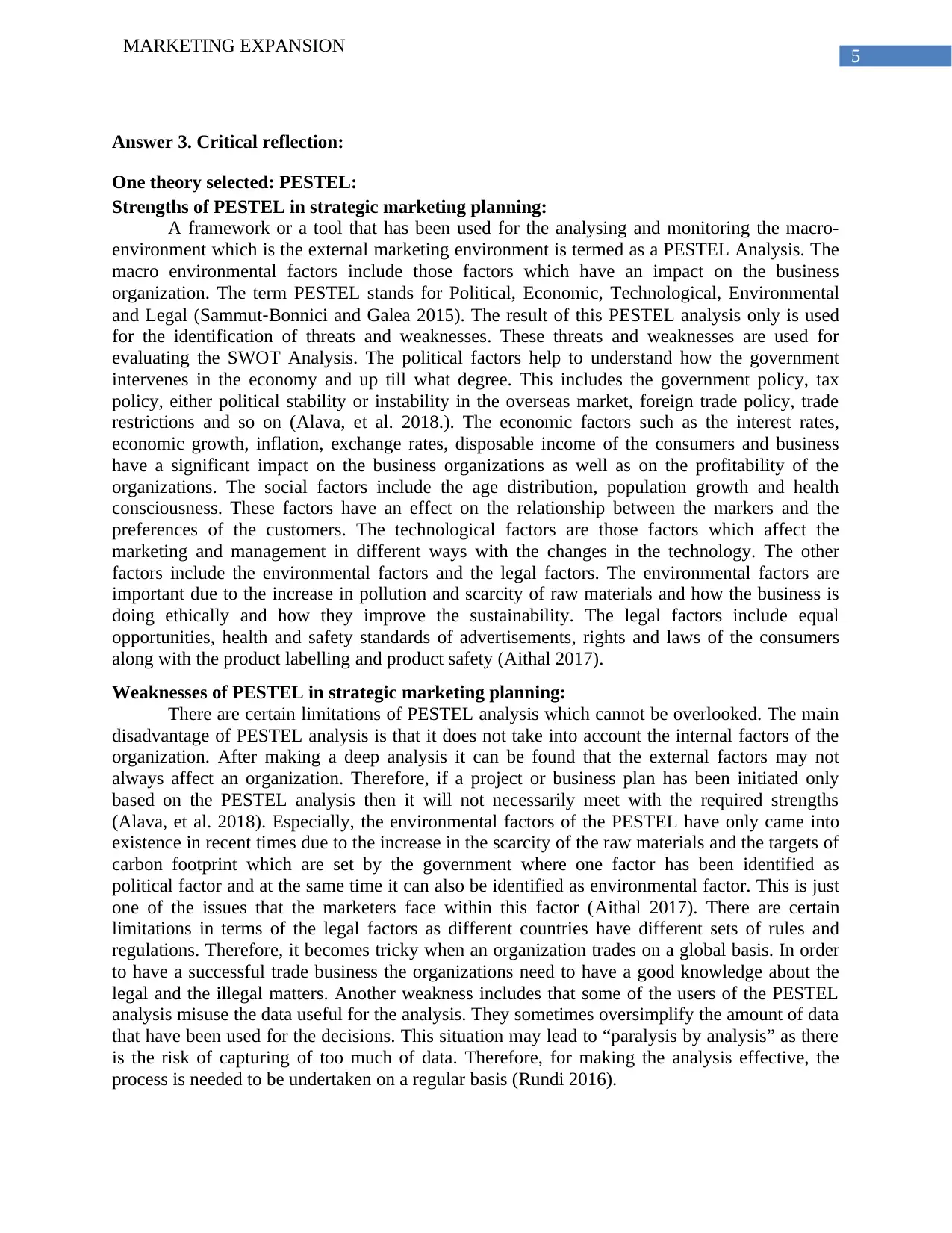
5
MARKETING EXPANSION
Answer 3. Critical reflection:
One theory selected: PESTEL:
Strengths of PESTEL in strategic marketing planning:
A framework or a tool that has been used for the analysing and monitoring the macro-
environment which is the external marketing environment is termed as a PESTEL Analysis. The
macro environmental factors include those factors which have an impact on the business
organization. The term PESTEL stands for Political, Economic, Technological, Environmental
and Legal (Sammut‐Bonnici and Galea 2015). The result of this PESTEL analysis only is used
for the identification of threats and weaknesses. These threats and weaknesses are used for
evaluating the SWOT Analysis. The political factors help to understand how the government
intervenes in the economy and up till what degree. This includes the government policy, tax
policy, either political stability or instability in the overseas market, foreign trade policy, trade
restrictions and so on (Alava, et al. 2018.). The economic factors such as the interest rates,
economic growth, inflation, exchange rates, disposable income of the consumers and business
have a significant impact on the business organizations as well as on the profitability of the
organizations. The social factors include the age distribution, population growth and health
consciousness. These factors have an effect on the relationship between the markers and the
preferences of the customers. The technological factors are those factors which affect the
marketing and management in different ways with the changes in the technology. The other
factors include the environmental factors and the legal factors. The environmental factors are
important due to the increase in pollution and scarcity of raw materials and how the business is
doing ethically and how they improve the sustainability. The legal factors include equal
opportunities, health and safety standards of advertisements, rights and laws of the consumers
along with the product labelling and product safety (Aithal 2017).
Weaknesses of PESTEL in strategic marketing planning:
There are certain limitations of PESTEL analysis which cannot be overlooked. The main
disadvantage of PESTEL analysis is that it does not take into account the internal factors of the
organization. After making a deep analysis it can be found that the external factors may not
always affect an organization. Therefore, if a project or business plan has been initiated only
based on the PESTEL analysis then it will not necessarily meet with the required strengths
(Alava, et al. 2018). Especially, the environmental factors of the PESTEL have only came into
existence in recent times due to the increase in the scarcity of the raw materials and the targets of
carbon footprint which are set by the government where one factor has been identified as
political factor and at the same time it can also be identified as environmental factor. This is just
one of the issues that the marketers face within this factor (Aithal 2017). There are certain
limitations in terms of the legal factors as different countries have different sets of rules and
regulations. Therefore, it becomes tricky when an organization trades on a global basis. In order
to have a successful trade business the organizations need to have a good knowledge about the
legal and the illegal matters. Another weakness includes that some of the users of the PESTEL
analysis misuse the data useful for the analysis. They sometimes oversimplify the amount of data
that have been used for the decisions. This situation may lead to “paralysis by analysis” as there
is the risk of capturing of too much of data. Therefore, for making the analysis effective, the
process is needed to be undertaken on a regular basis (Rundi 2016).
MARKETING EXPANSION
Answer 3. Critical reflection:
One theory selected: PESTEL:
Strengths of PESTEL in strategic marketing planning:
A framework or a tool that has been used for the analysing and monitoring the macro-
environment which is the external marketing environment is termed as a PESTEL Analysis. The
macro environmental factors include those factors which have an impact on the business
organization. The term PESTEL stands for Political, Economic, Technological, Environmental
and Legal (Sammut‐Bonnici and Galea 2015). The result of this PESTEL analysis only is used
for the identification of threats and weaknesses. These threats and weaknesses are used for
evaluating the SWOT Analysis. The political factors help to understand how the government
intervenes in the economy and up till what degree. This includes the government policy, tax
policy, either political stability or instability in the overseas market, foreign trade policy, trade
restrictions and so on (Alava, et al. 2018.). The economic factors such as the interest rates,
economic growth, inflation, exchange rates, disposable income of the consumers and business
have a significant impact on the business organizations as well as on the profitability of the
organizations. The social factors include the age distribution, population growth and health
consciousness. These factors have an effect on the relationship between the markers and the
preferences of the customers. The technological factors are those factors which affect the
marketing and management in different ways with the changes in the technology. The other
factors include the environmental factors and the legal factors. The environmental factors are
important due to the increase in pollution and scarcity of raw materials and how the business is
doing ethically and how they improve the sustainability. The legal factors include equal
opportunities, health and safety standards of advertisements, rights and laws of the consumers
along with the product labelling and product safety (Aithal 2017).
Weaknesses of PESTEL in strategic marketing planning:
There are certain limitations of PESTEL analysis which cannot be overlooked. The main
disadvantage of PESTEL analysis is that it does not take into account the internal factors of the
organization. After making a deep analysis it can be found that the external factors may not
always affect an organization. Therefore, if a project or business plan has been initiated only
based on the PESTEL analysis then it will not necessarily meet with the required strengths
(Alava, et al. 2018). Especially, the environmental factors of the PESTEL have only came into
existence in recent times due to the increase in the scarcity of the raw materials and the targets of
carbon footprint which are set by the government where one factor has been identified as
political factor and at the same time it can also be identified as environmental factor. This is just
one of the issues that the marketers face within this factor (Aithal 2017). There are certain
limitations in terms of the legal factors as different countries have different sets of rules and
regulations. Therefore, it becomes tricky when an organization trades on a global basis. In order
to have a successful trade business the organizations need to have a good knowledge about the
legal and the illegal matters. Another weakness includes that some of the users of the PESTEL
analysis misuse the data useful for the analysis. They sometimes oversimplify the amount of data
that have been used for the decisions. This situation may lead to “paralysis by analysis” as there
is the risk of capturing of too much of data. Therefore, for making the analysis effective, the
process is needed to be undertaken on a regular basis (Rundi 2016).
⊘ This is a preview!⊘
Do you want full access?
Subscribe today to unlock all pages.

Trusted by 1+ million students worldwide
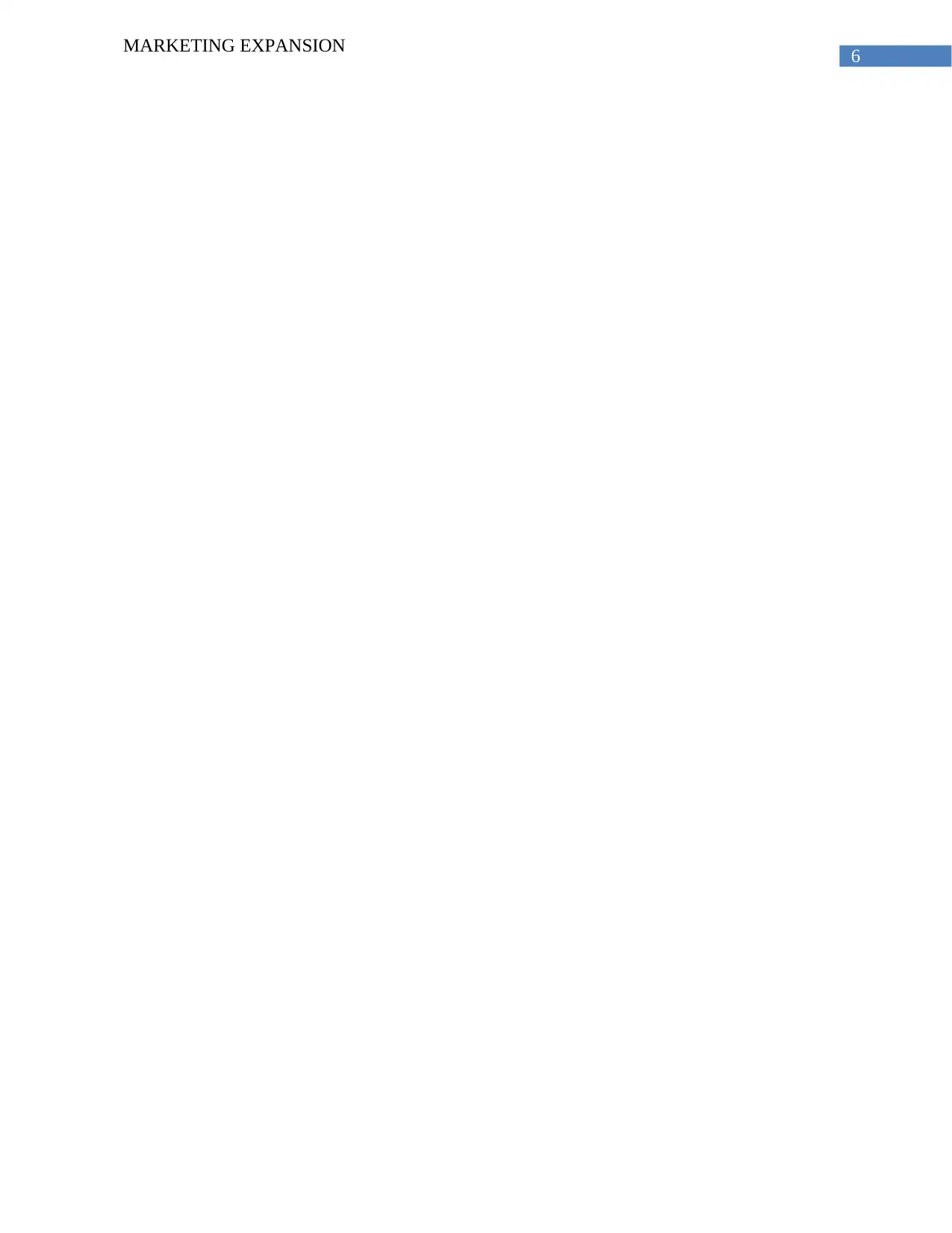
6
MARKETING EXPANSION
MARKETING EXPANSION
Paraphrase This Document
Need a fresh take? Get an instant paraphrase of this document with our AI Paraphraser
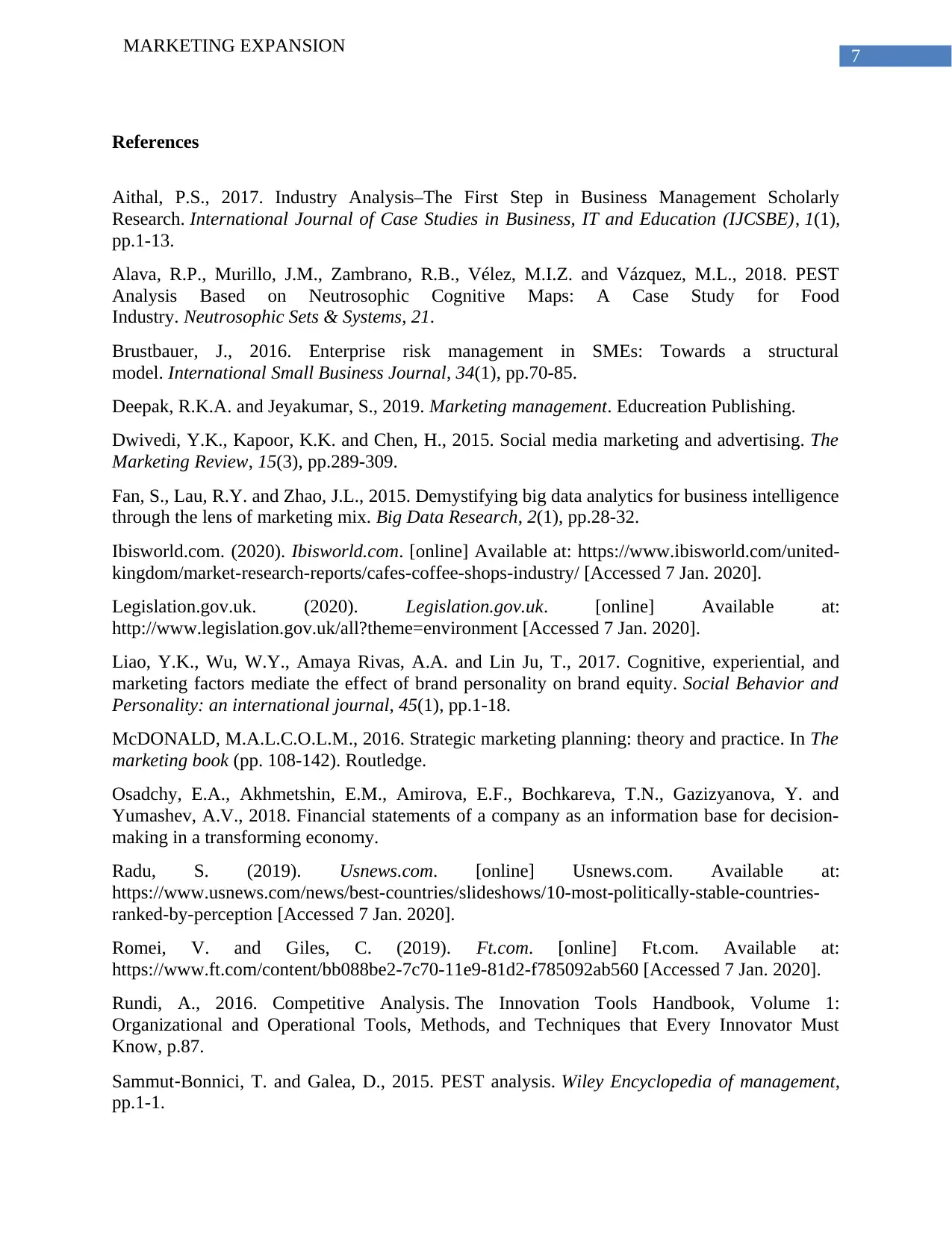
7
MARKETING EXPANSION
References
Aithal, P.S., 2017. Industry Analysis–The First Step in Business Management Scholarly
Research. International Journal of Case Studies in Business, IT and Education (IJCSBE), 1(1),
pp.1-13.
Alava, R.P., Murillo, J.M., Zambrano, R.B., Vélez, M.I.Z. and Vázquez, M.L., 2018. PEST
Analysis Based on Neutrosophic Cognitive Maps: A Case Study for Food
Industry. Neutrosophic Sets & Systems, 21.
Brustbauer, J., 2016. Enterprise risk management in SMEs: Towards a structural
model. International Small Business Journal, 34(1), pp.70-85.
Deepak, R.K.A. and Jeyakumar, S., 2019. Marketing management. Educreation Publishing.
Dwivedi, Y.K., Kapoor, K.K. and Chen, H., 2015. Social media marketing and advertising. The
Marketing Review, 15(3), pp.289-309.
Fan, S., Lau, R.Y. and Zhao, J.L., 2015. Demystifying big data analytics for business intelligence
through the lens of marketing mix. Big Data Research, 2(1), pp.28-32.
Ibisworld.com. (2020). Ibisworld.com. [online] Available at: https://www.ibisworld.com/united-
kingdom/market-research-reports/cafes-coffee-shops-industry/ [Accessed 7 Jan. 2020].
Legislation.gov.uk. (2020). Legislation.gov.uk. [online] Available at:
http://www.legislation.gov.uk/all?theme=environment [Accessed 7 Jan. 2020].
Liao, Y.K., Wu, W.Y., Amaya Rivas, A.A. and Lin Ju, T., 2017. Cognitive, experiential, and
marketing factors mediate the effect of brand personality on brand equity. Social Behavior and
Personality: an international journal, 45(1), pp.1-18.
McDONALD, M.A.L.C.O.L.M., 2016. Strategic marketing planning: theory and practice. In The
marketing book (pp. 108-142). Routledge.
Osadchy, E.A., Akhmetshin, E.M., Amirova, E.F., Bochkareva, T.N., Gazizyanova, Y. and
Yumashev, A.V., 2018. Financial statements of a company as an information base for decision-
making in a transforming economy.
Radu, S. (2019). Usnews.com. [online] Usnews.com. Available at:
https://www.usnews.com/news/best-countries/slideshows/10-most-politically-stable-countries-
ranked-by-perception [Accessed 7 Jan. 2020].
Romei, V. and Giles, C. (2019). Ft.com. [online] Ft.com. Available at:
https://www.ft.com/content/bb088be2-7c70-11e9-81d2-f785092ab560 [Accessed 7 Jan. 2020].
Rundi, A., 2016. Competitive Analysis. The Innovation Tools Handbook, Volume 1:
Organizational and Operational Tools, Methods, and Techniques that Every Innovator Must
Know, p.87.
Sammut‐Bonnici, T. and Galea, D., 2015. PEST analysis. Wiley Encyclopedia of management,
pp.1-1.
MARKETING EXPANSION
References
Aithal, P.S., 2017. Industry Analysis–The First Step in Business Management Scholarly
Research. International Journal of Case Studies in Business, IT and Education (IJCSBE), 1(1),
pp.1-13.
Alava, R.P., Murillo, J.M., Zambrano, R.B., Vélez, M.I.Z. and Vázquez, M.L., 2018. PEST
Analysis Based on Neutrosophic Cognitive Maps: A Case Study for Food
Industry. Neutrosophic Sets & Systems, 21.
Brustbauer, J., 2016. Enterprise risk management in SMEs: Towards a structural
model. International Small Business Journal, 34(1), pp.70-85.
Deepak, R.K.A. and Jeyakumar, S., 2019. Marketing management. Educreation Publishing.
Dwivedi, Y.K., Kapoor, K.K. and Chen, H., 2015. Social media marketing and advertising. The
Marketing Review, 15(3), pp.289-309.
Fan, S., Lau, R.Y. and Zhao, J.L., 2015. Demystifying big data analytics for business intelligence
through the lens of marketing mix. Big Data Research, 2(1), pp.28-32.
Ibisworld.com. (2020). Ibisworld.com. [online] Available at: https://www.ibisworld.com/united-
kingdom/market-research-reports/cafes-coffee-shops-industry/ [Accessed 7 Jan. 2020].
Legislation.gov.uk. (2020). Legislation.gov.uk. [online] Available at:
http://www.legislation.gov.uk/all?theme=environment [Accessed 7 Jan. 2020].
Liao, Y.K., Wu, W.Y., Amaya Rivas, A.A. and Lin Ju, T., 2017. Cognitive, experiential, and
marketing factors mediate the effect of brand personality on brand equity. Social Behavior and
Personality: an international journal, 45(1), pp.1-18.
McDONALD, M.A.L.C.O.L.M., 2016. Strategic marketing planning: theory and practice. In The
marketing book (pp. 108-142). Routledge.
Osadchy, E.A., Akhmetshin, E.M., Amirova, E.F., Bochkareva, T.N., Gazizyanova, Y. and
Yumashev, A.V., 2018. Financial statements of a company as an information base for decision-
making in a transforming economy.
Radu, S. (2019). Usnews.com. [online] Usnews.com. Available at:
https://www.usnews.com/news/best-countries/slideshows/10-most-politically-stable-countries-
ranked-by-perception [Accessed 7 Jan. 2020].
Romei, V. and Giles, C. (2019). Ft.com. [online] Ft.com. Available at:
https://www.ft.com/content/bb088be2-7c70-11e9-81d2-f785092ab560 [Accessed 7 Jan. 2020].
Rundi, A., 2016. Competitive Analysis. The Innovation Tools Handbook, Volume 1:
Organizational and Operational Tools, Methods, and Techniques that Every Innovator Must
Know, p.87.
Sammut‐Bonnici, T. and Galea, D., 2015. PEST analysis. Wiley Encyclopedia of management,
pp.1-1.
1 out of 8
Related Documents
Your All-in-One AI-Powered Toolkit for Academic Success.
+13062052269
info@desklib.com
Available 24*7 on WhatsApp / Email
![[object Object]](/_next/static/media/star-bottom.7253800d.svg)
Unlock your academic potential
Copyright © 2020–2025 A2Z Services. All Rights Reserved. Developed and managed by ZUCOL.





